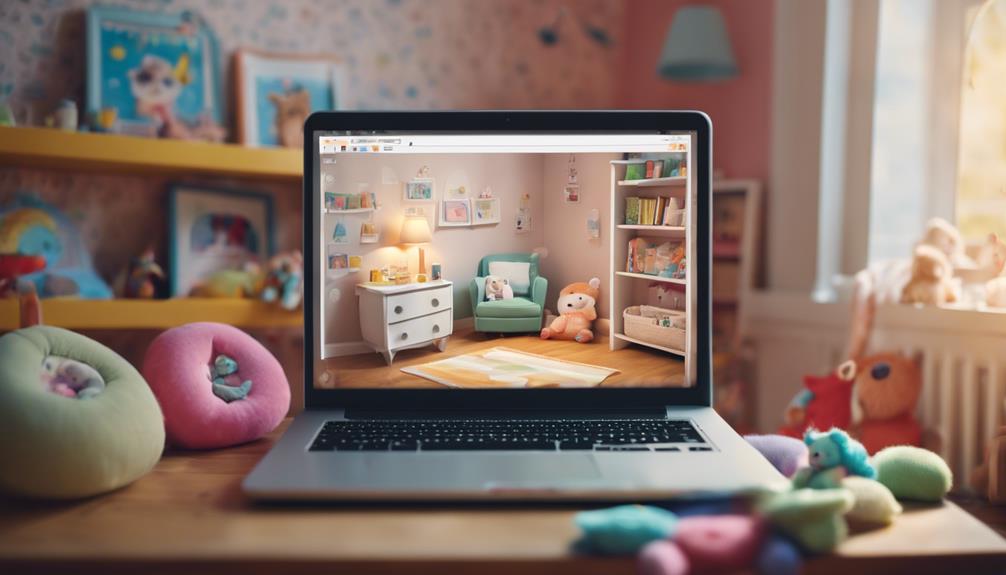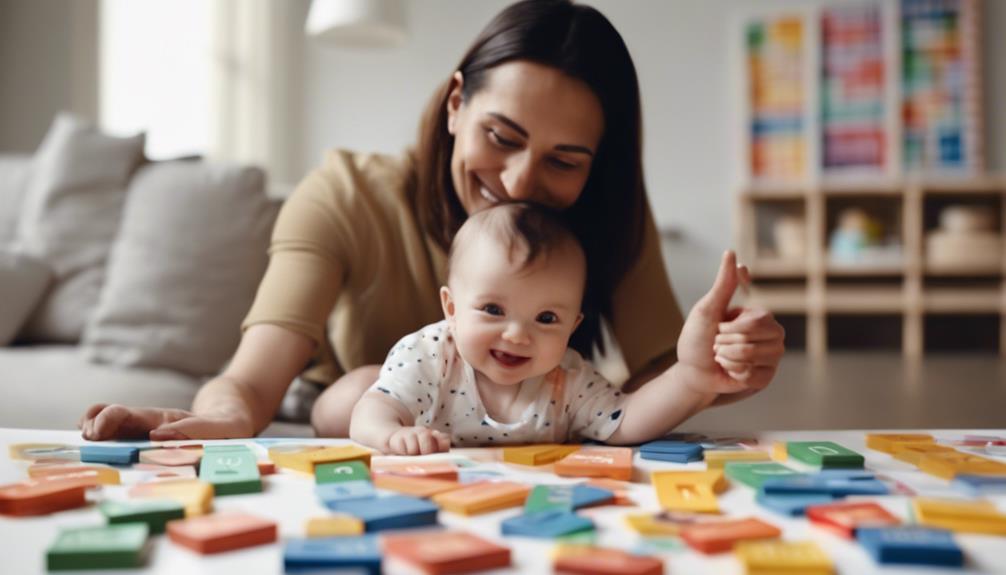To better understand your baby’s cues, observe subtle indicators such as stirring or sucking on hands, which can signal hunger or the need for comfort. It is important to respond promptly to prevent crying or distress. In addition, pay attention to mid-level cues like stretching or eye rubbing, which could indicate tiredness or hunger. Respond to hunger cues such as lip licking or turning towards the breast immediately. Strengthen the bond with your baby by recognizing playful cues that promote development and communication. Also, be mindful of signals for breaks like squirming or lack of eye contact to prevent overstimulation. By mastering these cues, you can enhance your connection and support your baby’s growth. Continue to explore to gain a deeper understanding of your baby’s communication cues.
Key Takeaways
- Recognize subtle signs like stirring or mouth movements to address baby's needs promptly.
- Interpret mid-cues such as stretching and hand movements to establish a feeding routine.
- Respond promptly to hunger signals like sucking on hands to support growth and bonding.
- Understand sleep cues like rubbing eyes or fussiness to promote healthy sleep habits.
- Decode hunger cues like licking lips or crying to establish a feeding routine effectively.
Recognizing Early Cues
To effectively respond to your baby's needs, you must first learn to recognize their early cues. These subtle signs, such as stirring, mouth opening, and turning the head, serve as indicators of your baby's hunger or need for comfort. By paying close attention to these baby cues, you can address their needs promptly before they escalate to crying or distress.
Learning your baby's cues is essential in fostering a strong bond and promoting a sense of security for your little one. These early cues act as gentle reminders from your baby, signaling their requirements before they become urgent.
Responding promptly to these cues not only guarantees that your baby's needs are met in a timely manner but also helps in preventing them from reaching a state of agitation.
Interpreting Mid-Cues

Recognize subtle signs like stretching, physical movements, and bringing hands to the mouth as mid-cues that indicate your baby is getting hungry and needs to be fed soon. These mid-cues are important indicators that your baby wants to eat and needs a break. By understanding and responding to these cues promptly, you can prevent your baby from becoming overly hungry or agitated.
It's vital to pay close attention to these subtle signals, as mid-cues can be easily missed if you're not observant.
Responding promptly to mid-cues can help establish a feeding routine and make sure that your baby's nutritional needs are met in a timely manner. By recognizing these mid-cues early on, you can create a positive feeding experience for both you and your baby.
Responding to 'Feed Me' Signals
When your baby begins showing hunger cues such as sucking on hands or increased alertness, it's essential to respond promptly to meet their nutritional needs.
By recognizing these early signs of hunger, you can establish a healthy feeding pattern and support your baby's growth.
Understanding the timing of feedings and practicing responsive feeding can help strengthen the bond between you and your little one.
Hunger Cues Recognition
During feeding time, pay close attention to your baby's hunger cues like stirring, mouth opening, and turning head to respond promptly. Learning your baby's hunger signals is essential for ensuring they receive the nourishment they need.
Here are some key hunger cues to look out for:
- Stirring: Your baby may start moving more restlessly or squirming.
- Mouth Opening: They might open and close their mouth repeatedly.
- Turning Head: Your baby may turn their head from side to side.
- Stretching: Some babies stretch their bodies when they're hungry.
- Crying and Agitation: These are late hunger cues indicating your baby is already upset due to hunger.
Timing of Feeding
Paying attention to your baby's hunger cues and responding promptly can help establish a healthy feeding routine. Recognizing the signs that your baby is ready to eat is important to make sure they receive proper nutrition and stay content. Here are some cues to look for and the ideal timing to feed your baby:
| Early Hunger Cues | Mid-Level Hunger Cues |
|---|---|
| Stirring | Stretching |
| Mouth opening | Hand to mouth movements |
When your baby displays early cues like stirring or mouth opening, it's a good time to start feeding. If you wait until your baby cries from extreme hunger, they may become more agitated and harder to calm for feeding. By timing your baby's feeding based on their cues, you can create a smoother and more enjoyable feeding experience for both you and your little one.
Responsive Feeding Practices
Recognizing your baby's 'Feed Me' signals promptly is vital for establishing a healthy feeding routine and guaranteeing their nutritional needs are met. When your baby is ready to eat, it's important to respond promptly to their cues to maintain a balanced feeding pattern. Here are some key points to keep in mind:
- Early Hunger Cues: Keep an eye out for signs like stirring, mouth opening, and turning their head towards you. Responding to these cues promptly can prevent your baby from becoming upset and help meet their feeding needs effectively.
- Mid Hunger Cues: Watch for signals such as stretching, physical movements, and hand-to-mouth actions. These actions indicate that your baby is ready for feeding and should be addressed promptly to ensure their comfort.
- 'Feed Me' Signals: Crying, agitation, and turning red are strong hunger signals that require immediate attention. Responding promptly to these cues is essential for understanding and meeting your baby's feeding requirements.
- Establishing a Routine: By recognizing and responding to your baby's hunger cues, you can establish a healthy feeding routine that meets their nutritional needs efficiently.
Understanding Sleep Cues

When it comes to understanding your baby's sleep cues, it's essential to pay attention to signals like rubbing their eyes, yawning, and fussiness. These signs indicate that your little one may be getting tired and ready for sleep.
Sleep Signals at Night
Understanding your baby's sleep signals at night is vital for promoting healthy sleep habits and ensuring restful nights for both of you. When your baby displays cues of tiredness in the evening, it's essential to pay attention and respond promptly.
Here are some common sleep signals your baby may exhibit at night:
- Rubbing Eyes: Your baby might rub their eyes when feeling sleepy, indicating it's time for bed.
- Yawning: Yawning is a clear sign of fatigue and can be a cue that your baby needs to rest.
- Fussiness: If your baby becomes fussy, it could mean they're tired and need soothing to settle down.
- Bedtime Routines: Establishing consistent bedtime routines can reinforce sleep cues and help your baby develop healthy sleep patterns.
- Prompt Response: Responding promptly to your baby's sleep cues can lead to better rest for both you and your little one, promoting a more peaceful night's sleep.
Daytime Nap Cues
During the day, observing your baby's cues for naps is essential in ensuring they get the rest they need for healthy development. Daytime nap cues can manifest in various ways, such as yawning, rubbing eyes, pulling ears, or displaying fussiness and clinginess.
When your baby shows these signs, it indicates that they're ready for a nap. By recognizing these cues promptly, you can establish a nap routine that aligns with your baby's needs, promoting good sleep habits.
Responding promptly to your baby's sleep cues is critical in preventing overtiredness, which can lead to difficulties in falling asleep and staying asleep. Meeting your baby's need for daytime naps not only supports their physical and cognitive development but also contributes to their overall well-being.
Therefore, paying attention to your baby's signals during the day and providing them with the rest they require is essential for their growth and health.
Tired Signs to Watch
Have you noticed the subtle signs indicating that your baby is tired and ready for sleep? Understanding your baby's tired cues is essential in helping them establish healthy sleep patterns. Here are some signs to watch for:
- Body Language: Your baby may display staring, jerky movements, or rubbing their eyes when they're tired.
- Yawning: Constant yawning can be a clear indication that your baby is ready for some rest.
- Fussing: Increased fussiness and irritability can signal that your baby is tired and needs to sleep.
- Sucking Fingers: Babies often suck on their fingers when they're tired, seeking comfort and soothing.
- Interact with Your Baby: Pay attention to how your baby responds to interactions; if they seem disengaged or unresponsive, they may be tired.
Recognizing these tired cues can help you respond promptly, preventing overtiredness and ensuring your baby feels secure and well-rested. By being attentive to these signs, you can support your baby in developing healthy sleep habits.
Decoding Hunger Cues
When your baby is hungry, they may exhibit cues such as licking their lips, sucking on fingers, and turning their head towards the breast. These actions signal that they're feeling the need for nourishment. In addition to these subtle cues, crying and fussiness are also common signs that your baby is hungry.
It's important to respond promptly to these hunger cues to guarantee timely feeding and meet your baby's nutritional needs. Recognizing these hunger cues not only helps in establishing a feeding routine but also plays a significant role in strengthening the bond between caregiver and baby.
Noticing Playful Cues
Noticing playful cues from your baby can provide valuable insights into their readiness for interaction and play. When babies give off these cues, they're expressing their desire to engage with you in fun and stimulating activities.
Here are some key ways recognizing and responding to these cues can help your baby:
- Enhance Bonding: Responding to playful cues helps build a strong bond between you and your baby, fostering a sense of closeness and security.
- Boost Development: Encouraging these cues can enhance your baby's cognitive development and social skills, supporting their overall growth and learning.
- Promote Joyful Interaction: Understanding and responding to playful cues contribute to positive and joyful interactions between you and your baby.
- Stimulate Interest: By engaging with your baby when they show playful cues, you help maintain their interest and enjoyment in social interactions and playtime.
- Encourage Communication: Playful cues can also be an early form of communication from your baby, indicating their willingness to interact and engage with you.
Acknowledging Signals for Breaks

Recognize the signs indicating your baby needs a break, such as squirming, lack of eye contact, head turning away, and arching back. When you notice these cues happening around, it's vital to understand that your baby needs something.
Stiffness, making fists, and changes in skin color are additional signals that suggest your baby is tired and requires a break. To help settle your baby during these moments, providing a calm environment, gentle holding, and soft touch can make a significant difference.
Swaddling your baby snugly but comfortably, offering a pacifier, or providing a soft surface for them to press against can aid in soothing them.
By recognizing signs of fatigue or overstimulation promptly and responding appropriately, you can help prevent meltdowns and create a sense of safety and security for your baby.
Frequently Asked Questions
How to Read Your Baby's Cues?
To read your baby's cues, pay attention to their sounds, movements, and body language. Respond promptly to signals like tiredness, hunger, or play readiness. Engage with interaction and observation to strengthen your bond and support their development.
Why Is It Important for Educators to Read an Infant's Cues Accordingly?
To truly connect with infants, reading their cues is like deciphering a secret language. It's essential for educators as it fosters trust, meets needs promptly, and creates a nurturing environment, enhancing infant development and well-being.
What Are the 4 Ways Infants Communicate?
Infants communicate through crying, body movements, facial expressions, and vocalizations. Understanding these cues helps you meet their needs effectively. Pay attention to their signals to build a strong connection and respond appropriately to their emotions.
What Are the 3 Ways That a Baby Communicates?
When your baby communicates, they use crying, body language, and facial expressions. Recognize cues like yawning or smacking lips for tiredness and hunger. Responding to their signals builds a strong bond between you.
Conclusion
To sum up, understanding your baby's cues is essential for effective communication and meeting their needs. By recognizing and responding to early, mid, and hunger cues, as well as signals for sleep, play, and breaks, you can foster a deeper connection with your little one.
Remember, communication is a two-way street, and by tuning into your baby's subtle cues, you can create a harmonious and fulfilling relationship. So, pay attention, be present, and watch your bond flourish.










